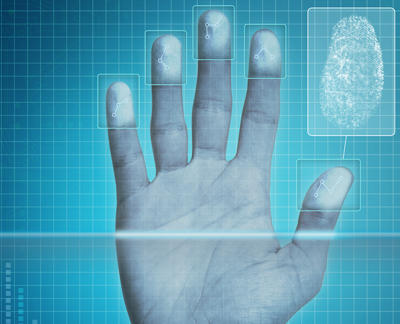
Quickly moving through security checkpoints by showing your hand to a scanner seems straight out of science fiction, but the National Institute of Standards and Technology (NIST) is working with industry to bring fast, touchless fingerprint readers out of the lab and into the marketplace.
The touchless technology offers unprecedented speed and a hygienic alternative to conventional fingerprint readers. But before the contactless fingerprint technology can be used broadly, the products must be evaluated and proven to work with millions of existing contact-based fingerprint records.
Enter NIST.
When it comes to biometrics—including fingerprints—the U.S. government relies on NIST to develop data format standards, best practices and methods for certification testing and to demonstrate a new product's ability to work with existing technology.
NIST conducts its research on contactless fingerprinting devices with the Federal Bureau of Investigation Biometric Center of Excellence. The partnership's goal is to develop common requirements, metrics and open testing methods for this new fingerprint technology that will support future certification for purchase on the Government Certified Products lists.
Researchers at NIST are working with contactless fingerprint devices from MorphoTrak, LLC, and 3M Company through Cooperative Research and Development Agreements (CRADAs). NIST continues to seek new CRADA partners.
"The largest challenge we are facing is that this new technology produces images that are fundamentally different than existing images," says Michael Garris, NIST biometrics senior scientist.
Because skin is elastic, traditional fingerprints contain natural distortion from the pressure of placing the finger on the fingerprinting surface, Garris explains. Contactless fingerprints are pressure free and will look different.
There are also many types of sensors being used for contactless fingerprint capture. They are significantly different from the sensors used to obtain contact-based fingerprints, so the touchless scans have different image properties.
"It is very difficult for NIST or technology developers to address these issues independently," explains Garris. "The CRADA provides a trustworthy environment for industry to come together and openly work with NIST."
NIST is developing methods, metrics and targets to test these devices to determine if they are reliable, accurate and can work with legacy systems. The first step is to develop models to measure image fidelity on the new systems, including developing calibration patterns that can be used as optical targets to determine resolution, focus, contrast, spatial consistency and other properties of fingerprints.
The researchers also are investigating materials for use as synthetic targets for testing, such as aluminum, polycarbonate and NIST-developed materials that can mimic the pigmentation and light-diffusion properties of human tissue.
For more information on participating in the CRADA, see www.nist.gov/itl/iad/ig/crada_contactless.cfm.

